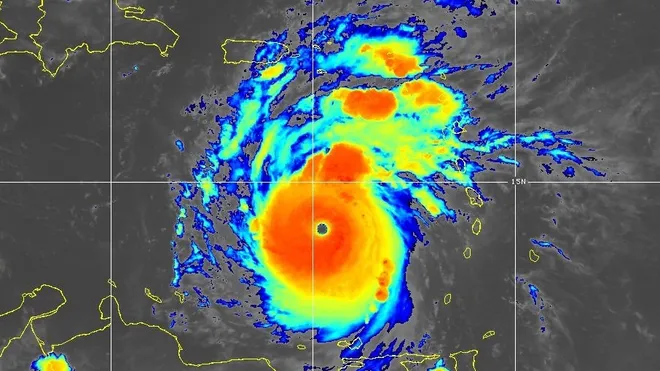Hurricane Beryl has ripped through the Caribbean, leaving a trail of devastation in its wake. The storm’s impact has resulted in at least one confirmed fatality and widespread damage. Island nations are contending with power outages, flooding, and severe damage to infrastructure. Emergency responders are working diligently to assess the situation and provide assistance to those affected. The tragedy serves as a stark reminder of the increasing threat posed by hurricanes, particularly in the context of climate change.
Key Points
1. Hurricane Beryl’s Devastation
Hurricane Beryl made landfall, claiming at least one life and causing significant damage.
2. Aftermath and Response
Island nations are grappling with power outages, flooding, and infrastructure damage. Emergency response teams are working tirelessly to assess the damage and provide aid.
3. Role of Climate Change
Climate change is exacerbating the intensity and unpredictability of hurricanes, posing a growing threat to Caribbean islands.
4. Vulnerability of Island Nations
The tragedy underscores the vulnerability of island nations to extreme weather events.
5. International Cooperation
International cooperation and support are essential for recovery and rebuilding efforts.
Hurricane Beryl’s Impact
Landfall and Initial Damage
Hurricane Beryl made a devastating landfall, unleashing heavy rainfall, powerful winds, and dangerous storm surges. The immediate impact was severe, with at least one life claimed and numerous others affected by the storm’s fury.
Casualties and Immediate Consequences
The confirmed fatality underscores the human cost of the storm. In addition to the loss of life, many residents are facing the destruction of their homes and communities. The immediate consequences are dire, with significant damage to infrastructure and essential services disrupted.
The Aftermath: Damage and Response
Power Outages and Flooding
Widespread power outages have left many residents in the dark, compounding the challenges faced in the aftermath of the storm. Flooding has inundated homes and streets, making rescue and relief efforts more difficult.
Infrastructure Damage
The storm has caused extensive damage to infrastructure, including roads, bridges, and buildings. The destruction of critical infrastructure hampers the delivery of aid and complicates recovery efforts.
Emergency Response Efforts
Emergency response teams are on the ground, working around the clock to provide aid to those affected. Their efforts include search and rescue operations, distribution of supplies, and medical assistance. The dedication and bravery of these responders are crucial in the wake of such disasters.
The Role of Climate Change
Intensifying Storms
Climate change is playing a significant role in the increasing intensity and frequency of hurricanes. Warmer ocean temperatures and changing weather patterns contribute to the formation of more powerful storms like Hurricane Beryl.
Scientific Evidence and Predictions
Scientific research indicates that the trend of intensifying hurricanes is likely to continue. Predictions suggest that future storms could become even more destructive, posing a growing threat to vulnerable regions.
Vulnerability of Island Nations
Geographic and Economic Factors
Island nations are particularly vulnerable to hurricanes due to their geographic location and limited resources. The economic impact of such disasters can be devastating, affecting tourism, agriculture, and local economies.
Challenges in Disaster Preparedness
Preparing for and responding to hurricanes is a significant challenge for island nations. Limited infrastructure, financial constraints, and logistical hurdles make it difficult to implement effective disaster preparedness measures.
Importance of Early Warning Systems
Current Systems in Place
Early warning systems play a critical role in mitigating the impact of hurricanes. These systems provide timely information that allows residents to evacuate and take necessary precautions.
Improvements Needed
While existing systems have saved lives, there is a need for continuous improvement. Enhancing the accuracy and reach of early warning systems can further reduce casualties and damage.
International Cooperation and Support
Aid and Recovery Efforts
International aid is crucial for the recovery of affected regions. Financial assistance, supplies, and expertise from the global community can significantly aid in rebuilding efforts.
Global Solidarity and Long-term Assistance
Long-term support is essential for helping island nations build resilience against future storms. Global solidarity in addressing climate change and providing sustainable aid can make a substantial difference.
Building Resilience for the Future
Investing in Infrastructure
Investing in resilient infrastructure is vital for minimizing damage from future hurricanes. This includes building stronger homes, reinforcing critical facilities, and improving drainage systems.
Community Preparedness and Education
Educating communities about disaster preparedness and response is crucial. Programs that teach residents how to protect themselves and their property can save lives and reduce damage.
Conclusion
Beyond the immediate aftermath, the impact of Hurricane Beryl highlights the need for a two-pronged approach: bolstering immediate disaster response capabilities and addressing the root causes of climate change. Investing in resilient infrastructure, early warning systems, and community preparedness programs is crucial. Simultaneously, global efforts to curb greenhouse gas emissions and mitigate climate change are essential to protect vulnerable regions like the Caribbean from the escalating threat of extreme weather events.
Frequently Asked Questions (FAQs)
What was the impact of Hurricane Beryl on the Caribbean?
Hurricane Beryl caused at least one fatality and widespread damage, including power outages, flooding, and severe infrastructure damage.
How are emergency responders addressing the aftermath of Hurricane Beryl?
Emergency responders are conducting search and rescue operations, distributing supplies, and providing medical assistance to those affected by the storm.
What role does climate change play in the intensity of hurricanes like Beryl?
Climate change contributes to the increasing intensity and frequency of hurricanes due to warmer ocean temperatures and changing weather patterns.
Why are island nations particularly vulnerable to hurricanes?
Island nations are vulnerable due to their geographic location and limited resources, making it challenging to prepare for and respond to hurricanes.
How can early warning systems be improved to mitigate hurricane impacts?
Improving the accuracy and reach of early warning systems can provide timely information, allowing residents to evacuate and take necessary precautions.
What is the importance of international cooperation in hurricane recovery efforts?
International cooperation provides financial assistance, supplies, and expertise essential for recovery and rebuilding efforts, supporting long-term resilience.



